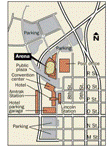Community and Regional Planning Program

Community and Regional Planning Program: Faculty Scholarly and Creative Activity
Document Type
Article
Date of this Version
5-10-2020
Citation
Published in Land Use Policy 96 (2020) 104715 DOI:10.1016/j.landusepol.2020.104715
Abstract
Urbanization has widely known to directly consume swaths of cropland worldwide. Knowledge on what kinds of urbanization processes spared cropland is important for land use planning. This study offered insights on the impact of city level (city hierarchy: from the 1st to the 6th Tier cities) and urbanization modes (mega-city, city, town and village modes) on cropland losses through a first-ever continuous national survey on 345 prefectural level cities or above in mainland China from 2003 to 2016. We found that higher tier cities were associated with more direct and severe losses. Specifically, over 80% of the recent urbanization formed on cropland in the 1st Tier cities, and the newly 1st Tier cities suffered the most rigorous losses. At national level, mega-city mode urbanization resulted in direct cropland losses (80%) and the village mode was associated with prominent high-quality ratio (45%). Town mode spared cropland more than village mode. However, ranking with urbanization mode was less obvious and even changed in the lower-Tier cities. At national scale, around 1.45% of the total cropland area (approximately 2297 km² per year), including 1.06% of high-quality cropland area (approximately 852 km² per year), has been permanently lost. The most rapid cropland loss was in 2009 (3464 km2), and that of high-quality cropland occurring in 2007 (1775 km2). Over 95% cropland losses located in the east of the Hu line. Findings in this study called for target adaptive planning with full considerations of city hierarchy and urbanization mode. Particularly, land use policies to effective support land development in small towns can potentially relief pressure on cropland.


Comments
Copyright © 2020 Elsevier Ltd. Used by permission.